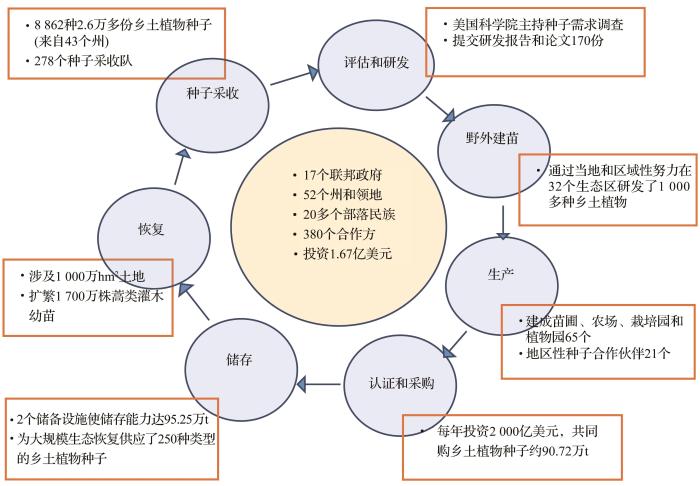

Progress of the US National Seed Strategy for Rehabilitation and Restoration and Inspirations for Rehabilitation in China
Received date: 2022-08-31
Revised date: 2022-10-04
Online published: 2022-11-16
Supported by
Projcet supported by the National Natural Science Foundation of China “Characteristics of snow cover and it’s effects on revegetation for mine land in dry and cold regions, Xinjiang”(42067068);The Key Project for College and University of Xinjiang “Effects of snow cover on seed dormancy release of two shrubs for revegetation in arid region”(XJEDU2019I020)
Ecological restoration is a worldwide challenge but is constrained by the lack of sufficient and viable native plant material. High-quality native plant material, including seeds, is key to ecosystem restoration and conservation. In 2015, the United States National Seed Strategy for Rehabilitation and Restoration was developed by the Plant Conservation Alliance in partnership with 12 federal agencies and over 300 non-federal cooperators in the United States. Its mission is to ensure the availability of genetically appropriate native seeds for restoration in the United States. With the vision of depositing the right seed in the right place at the right time, the four goals of the strategy are to: identify seed needs and ensure the reliable availability of genetically appropriate seeds; identify research needs and conduct research to provide genetically appropriate seeds; improve technology for native seed production and ecosystem restoration; and develop tools that enable managers to make timely, informed seeding decisions for ecological restoration. Develop strategies for internal and external communication. The strategy made great accomplishments during 2015-2020 by establishing nationwide networks of seed collectors, researchers to develop seeds, farmers to grow native seeds, nurseries and seed storage facilities to supply adequate quantities of appropriate seeds, and restoration ecologists who knew how to place the right seed in the right place at the right time. Understanding the background, goals, and progress of this strategy will help to improve the pace and scale of ecological restoration in China.

Xiaoying ZHAO , Jianjun SONG , Wenzhi ZHAO . Progress of the US National Seed Strategy for Rehabilitation and Restoration and Inspirations for Rehabilitation in China[J]. Advances in Earth Science, 2022 , 37(11) : 1204 -1210 . DOI: 10.11867/j.issn.1001-8166.2022.075
| 1 | Plant Conservation Alliance (PCA). The US national?seed strategy for rehabilitation and restoration 2015-2020 [R]. Washington, D.C.: U.S. Department of the Interior, Bureau of Land Management, 2015. |
| 2 | UNEP, FAO. The UN decade on ecosystem restoration. 2021-2030 [R]. UNEP/FAO Factsheet, 2020. |
| 3 | 王建刚. “联合国生态系统恢复十年”行动计划启动[N]. 中国科学报, 2021-06-08(2). |
| 4 | 国家发展改革委员会,自然资源部. 全国重要生态系统保护和修复重大工程总体规划(2021—2035年)[R]. 2020. |
| 5 | OLDFIELD S, OLWELL P. The right seed in the right place at the right time[J]. BioScience, 2015, 65(10): 955-956. |
| 6 | HAIDET M, OLWELL P. Seeds of success: a national seed banking program working to achieve long-term conservation goals[J]. Natural Areas Journal, 2015, 35(1): 165-173. |
| 7 | LEGER E A, BAUGHMAN O W. What seeds to plant in the great basin?Comparing traits prioritized in native plant cultivars and releases with those that promote survival in the field[J]. Natural Areas Journal, 2015, 35(1): 54-68. |
| 8 | WOOD T E, DOHERTY K, PADGETT W. Development of native plant materials for restoration and rehabilitation of Colorado Plateau ecosystems[J]. Natural Areas Journal, 2015, 35(1): 134-150. |
| 9 | Plant Conservation Alliance (PCA). The US National?seed strategy for rehabilitation and restoration 2015-2020:progress report 2015-2020 [R]. Washington, D.C.: U.S. Department of the Interior, Bureau of Land Management, 2021. |
| 10 | MCCORMICK M L, CARR A N, MASSATTI R, et al. How to increase the supply of native seed to improve restoration success: U.S. native seed development process[J]. Restoration Ecology, 2021, 29(8): e13499. |
| 11 | Bureau of Land Management (BLM). Technical protocol for the collection, study, and conservation of seeds from native plant species for Seeds of Success[Z]. 2018. |
| 12 | HAVENS K, VITT P, STILL S, et al. Seed sourcing for restoration in an era of climate change[J]. Natural Areas Journal, 2015, 35(1): 122-133. |
| 13 | Forest Service (USFS) U.S.. Tree Seed Zone Map. Portland, OR: USDA forest service in cooperation with the Western Forest Tree Seed Council[R/OL]. [2022-08-26]. . |
| 14 | Agricultural Resource Service (ARS), U.S. Department of Agriculture (USDA). Plant hardiness zone map[R/OL]. [2022-08-26]. . |
| 15 | BOWER A D, St CLAIR J B, ERICKSON V. Generalized provisional seed zones for native plants[J]. Ecological Applications: a Publication of the Ecological Society of America, 2014, 24(5): 913-919. |
| 16 | KRAMER A T, LARKIN D J, FANT J B. Assessing potential seed transfer zones for five forb species from the Great Basin floristic region, USA[J]. Natural Areas Journal, 2015, 35(1): 174-188. |
| 17 | SHRYOCK D F, DEFALCO L A, ESQUE T C. Empirical and provisional seed transfer zones for the Mojave Desert and surrounding regions (ver. 2.0, January 2021): U.S. Geological Survey data release[R/OL].[2022-08-26].. |
| 18 | MASSATTI R. Genetically informed seed transfer zones for Cleome lutea and Machaeanthera canescens across the Colorado Plateau and adjacent regions[R]. Bureau of Land Management, 2020. |
| 19 | PIKE C, POTTER K M, BERRANG P, et al. New seed-collection zones for the eastern United States: the eastern seed zone forum[J]. Journal of Forestry, 2020, 118(4): 444-451. |
| 20 | DUMROESE R K, LUNA T, RICHARDSON B A, et al. Conserving and restoring habitat for Greater Sage-Grouse and other sagebrush-obligate wildlife: the crucial link of forbs and sagebrush diversity[J]. Native Plants Journal, 2015, 16(3): 276-299. |
/
| 〈 |
|
〉 |